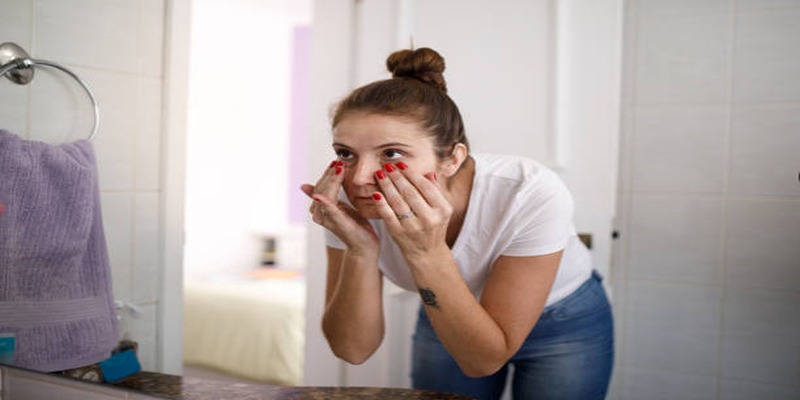Eye-Opening Insights: Busting Myths Around the Tear Trough
Mar 02, 2024 By Madison Evans
tear trough is a major concern for those looking to combat the signs of aging and generally highlight their radiant gaze. However, myths and misinformation have clouded the real issues people face with this delicate area. In this comprehensive exploration, we'll debunk some of the most entrenched myths around the tear trough, empowering readers with the knowledge to make informed decisions about their eye-area health and aesthetic treatments.
Myth 1: Dermal Fillers Are the Only Solution for Tear Trough Concerns:

It's a common belief that dermal fillers are the one-stop fix for hollow under-eye areas, but this is hardly the case. While fillers have revolutionized the aesthetic industry and can be very effective in certain cases, they are not always the optimal solution for tear trough concerns.
A Multifaceted Approach Yields the Best Results:
- Dermal fillers can often be used in conjunction with other treatments, such as microneedling or skin tightening procedures, to achieve the most natural and long-lasting results.
- In some cases, topical treatments or lifestyle changes may also be recommended to address specific underlying issues causing tear trough concerns, such as dehydration or lack of sleep.
- Consultation with a specialized practitioner is key in determining the best course of treatment for each individual, taking into account their unique concerns and goals.
Myth 2: Dark Circles and Under-Eye Hollows Are Always a Sign of Sleep Deprivation
Many assume that dark circles and under-eye hollows are solely indicative of sleep deprivation. While a lack of sleep can certainly exacerbate these conditions, it's not always the root cause.
A Complex Web of Contributing Factors
- Genetics, age, and skin tone all play a role in the appearance of dark circles and under-eye hollows. Some individuals are predisposed to have darker or thinner skin around the eyes, which can make these concerns more prominent.
- Sun exposure, smoking, and other environmental factors can also contribute to the breakdown of collagen and elastin in the delicate eye area, leading to hollows and dark circles.
- In some cases, allergies, sinus issues, or certain medical conditions can also contribute to the appearance of under-eye concerns.
Myth 3: Under-Eye Puffiness and Hollows Are Inversely Related
Another prevalent belief is that under-eye puffiness, commonly attributed to water retention, is inversely related to hollowing in the under-eye area. In other words, people assume that if you have one, you can't have the other. However, this is not always the case.
A Combination of Both Conditions is Possible
- It's important to note that under-eye puffiness and hollowing can coexist in the same individual. This can be due to a variety of factors, such as genetics or changes in facial structure over time.
- While some treatments may address one concern more than the other, it's important to address both concerns holistically for optimal results.
They Can Coexist and Are Addressed Differently
In truth, under-eye puffiness and hollowness are independent concerns that can coexist in the same individual. While puffiness is often caused by factors like fluid buildup or fat protrusion, hollows are typically related to volume loss or bone structure. Addressing these issues requires different approaches. For instance, puffiness might be reduced with the help of cold compresses or lymphatic drainage massages, whereas hollows may be better treated with fillers or surgical intervention if needed.
Myth 4: Surgery Is the Sole Path to Long-Term Tear Trough Correction

Cosmetic surgery is often seen as the final answer in the quest for youthful eyes. Many believe that it's the only way to achieve a permanent fix for under-eye concerns. However, this is far from the truth.
Non-Invasive Treatments Can Provide Long-Term Results
- With advances in technology and techniques, non-invasive treatments can now offer long-lasting results for tear trough concerns.
- Fillers, in particular, have evolved to provide more natural-looking and longer-lasting outcomes, making them a popular choice for addressing under-eye hollows.
- Other non-invasive treatments, such as radiofrequency or ultrasound skin tightening, can also provide long-term improvement in the appearance of under-eye concerns.
Non-Surgical Treatments Can Offer Durable Results
While surgery can provide a long-term solution, there are several non-surgical treatments that can offer durable results as well. Filler treatments can last anywhere from six months to two years and are frequently used for significant tear trough correction. Non-invasive procedures like radiofrequency and ultrasound therapy also help build and maintain collagen and elastin, supporting the skin structure over time.
Myth 5: Tear Trough Concerns Are Exclusively an Issue for the Elderly
The tear trough is often associated with aging and, consequently, as a concern that only affects the elderly population. This misconception can lead to indifference or delayed intervention in younger individuals who are also affected by under-eye hollowness or dark circles.
The Reality: Tear Trough Concerns Span All Age Groups
Under-eye hollows and puffiness can occur at any age and are influenced by a variety of genetic and environmental factors, not limited to age. Hylauronic acid fillers, for instance, are commonly used to treat under-eye hollowness in the young and middle-aged, providing a more refreshed and alert appearance. Targeted treatments should be customized to the individual's unique needs and age is only one of many considerations.
Conclusion:
Dark circles, hollows, and puffiness around the eyes are common concerns that can be caused by a variety of factors. It's important to dispel myths surrounding tear trough treatments and understand that these issues are not solely related to sleep deprivation or aging. With advancements in non-invasive treatments and skilled practitioners, under-eye concerns can be effectively addressed to achieve a refreshed, youthful appearance. Ultimately, personalized treatment plans based on individual needs and desired outcomes are key to achieving natural-looking and long-lasting results for tear trough concerns.

A Far-Reaching Guide to Calorie Deficit

What Are The Signs Of A Slowed Heart Rate?

On Silent Feet: Could You Be Suffering from Walking Pneumonia?

Understanding the Worst Places to Keep Your Skincare Products

Marvelous Menthol: Revealing Heroic Essence of Its Purifying Powers

What Are The Signs and Symptoms of High Blood Pressure: An Overview

Eye-Opening Insights: Busting Myths Around the Tear Trough


